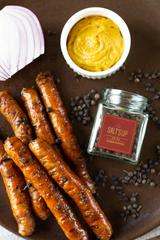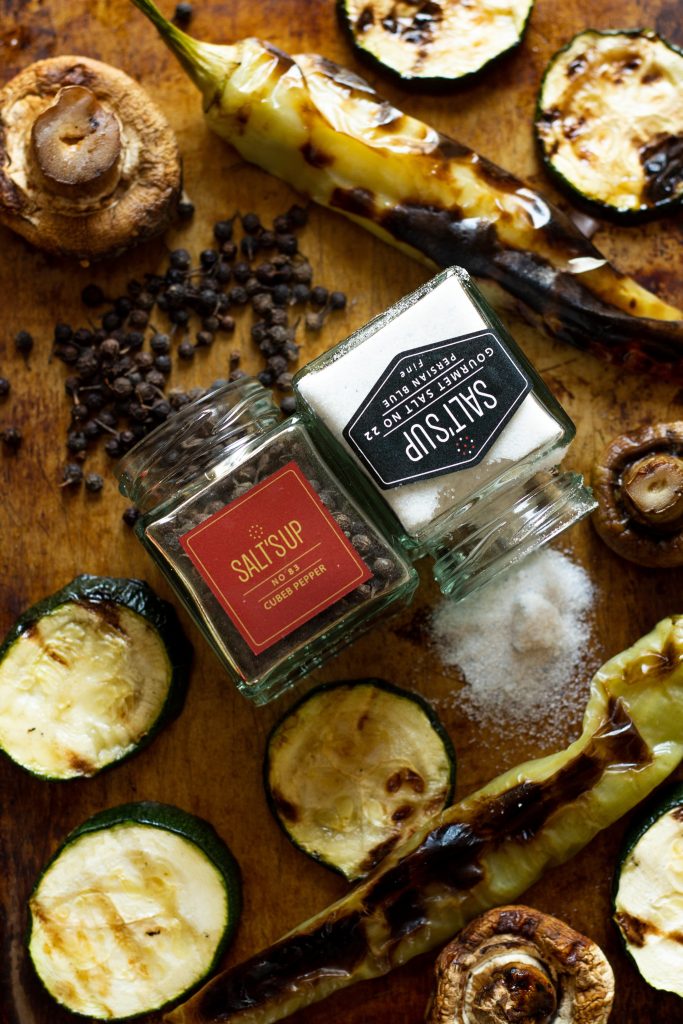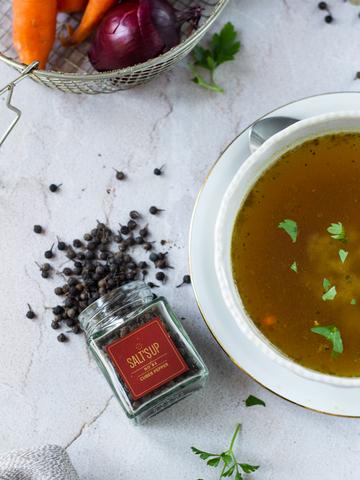Cubeb pepper or in Latin, Piper cubeba, is a spice used to flavor food and beverages. It is from the Piperaceae family and is classified as a pepper plant.
The cubeb pepper also goes by the name tailed pepper, because of the tapering end. cubeb berry is another title, to denote its berry like-shape. In India, the spice is referred to as kabab chini.
- Piper Cubeba Taste Profile
- Cubeb Pepper vs Black Pepper
- How to Store Cubeb Pepper
- Find out More About this Little Berry
- Historical Background of the Java Pepper
- How is Piper Cubeba Grown
- How to use the Cubeb Berry
- The Varied Uses in Cooking
- Cubeb Pepper in European and North American Kitchens
- Adding Cubeb Pepper to the Spice Mix
- Ras el Hanout
- To make this spice in your cupboard, you will need:
- Health and Medicinal Properties Of Tailed Peppers
- Cubeb Pepper in Home Remedies
- Why We Love the Cubeb Pepper
Piper Cubeba Taste Profile
Cubeb pepper contains terpenes, or aromatic plant compounds, further divided into monoterpenes and sesquiterpenes. This is the reason for the spice’s woody scent and taste.
Piper cubeba will first taste a bit spicy, followed by a bit bitter. Then, a clean almost eucalyptus flavor emerges, with a hint of citrus flavor. Many liken the taste of it to a cross between black pepper and allspice.
Cubeb Pepper vs Black Pepper
Cubeb pepper is not as hot as black pepper. In fact, it scores only a three out of ten in heat level. Black pepper contains a large number of piperidines, a naturally occurring organic compound, which contains the alkaloid piperine, and gives off a peppery taste. While cubeb pepper does not contain this at all.
How to Store Cubeb Pepper
Store whole spice in a cool dry place for up to 3 years. If freshly ground, use within three to six months. Always ensure your spice is encased in a glass bottle, with a tight-fitting lid, like the ones from Salt’s Up! Then, the store is in a cool dry place, away from sunlight.
Find out More About this Little Berry
The Cubeb pepper has a colorful history and a unique growth pattern. How exactly is Cubeb pepper used in cooking? What are its health properties? Read on!



Historical Background of the Java Pepper
Java and other islands from Indonesia have always been the primary source for this tailed pepper. To keep an economic hold on the prized Cubeb berry, farmers would sterilize seeds. This prevented the Java pepper seed from being stolen and then planted in foreign soil.
The Ancient Greek writings of philosopher Theophrastus, who died in 287 BC, illustrate that not only were the Greeks trading with Java but that the cubeb berry was being utilized.
The King of Portugal, wishing to create a strong trade bond with India, refused to import cubeb pepper from Java. Instead, the King only allowed the import of black pepper from his economic partner India.
Such embargos are cited as a reason for cubeb pepper’s decline in popularity, by the 16th century. It also explains why black pepper sits along with salt– in a salt and pepper shaker set!
How is Piper Cubeba Grown
The tree can grow up to 10 meters tall, preferring rich, humid soils. This tailed pepper, which once was exclusive to Indonesia, now is cultivated in India, the Lesser Antilles, Malaysia, and Sri Lanka. The thick rubbery leaves of the tree are dark green, and at maturity are 15 centimeters in length.
When in bloom, the tree is festooned with white blossoms, and small berries of five millimeters in size. These tailed berries are slightly larger than a peppercorn. Picked just before ripe, when still green, these berries are left in the sunshine to dry. Once dried, the berries become wrinkled and black.
How to use the Cubeb Berry
Cubeb pepper can be used whole, crushed, or added in with other spices to create a homemade spice mix. In both Indonesia and Malaysia, this tailed pepper is freshly ground and used to season dishes. There, it is the preferred pepper of choice over black pepper.
Today, spice is being used more in gourmet restaurants, where professional chefs are trying to add new flavors, beyond traditional black pepper.
It is a fact! This pepper is also used in the manufacturing of gin and cigars.
The Varied Uses in Cooking
Cubeb pepper appears most frequently in the cuisines of North Africa and Asia. In Morocco, it adds a flavourful taste to tagines and a number of other recipes. In Asia, it is often used as part of the spice in a curry.
In Australia, it is trendy for restaurant chefs to buy ingredients from the outback or tropical rainforest for tantalizing tastes. Cubeb pepper is popping up all over the continent for its exotic flavor.

Cubeb Pepper in European and North American Kitchens
Cubeb pepper is not yet a common ingredient in European and North American dishes.
Yet, ground cubeb pepper can enliven rice, and vegetables, as well as seafood, lamb, duck, and a wide variety of stews.
To make a vegetable, chicken, or beef stock, add six to eight whole cubeb berries to every liter of water. Once ready, strain out the cubeb peppers, along with the other ingredient in the stock.
In sweet applications, it pairs well with fruit and in the makeup of various ice creams, sorbets, and gelatos. Strain out the tailed berries before adding them to the ice cream maker.
Cubeb pepper also works well in mulled wine over the winter months. Use a light red wine and heat with cinnamon sticks, orange slices, and six cubeb berries per liter of wine. Bring to a simmer. Once the wine is warmed throughout, strain through a sieve, before serving in mugs.
Savvy bakers have found that cubeb pepper replaces allspice in recipes in equal measures. Think gingerbread cookies and cakes, as well as other mixed spice desserts.
Adding Cubeb Pepper to the Spice Mix
The flavor of cubeb pepper blends well with bay leaf, cardamon, curry leaf, cinnamon, rosemary, sage, thyme, and turmeric.
In India, families are known to create their own spice blends, which include, the cubeb pepper, and pass these recipes down through the generations. The blend remains each family’s secret.
Ras el Hanout
In Morocco, Ras el Hanout is the most popular blend. It can be used in specialty dishes such as mrouzia, a sweet and spicy lamb dish, or couscous tafia, with chicken or lamb. It can also find its way into any tagine or stew, using chicken meat or lamb. As well as a variety of soups.
To make this spice in your cupboard, you will need:
- 1 teaspoon cubeb pepper, ground
- 1 teaspoon salt
- 1 teaspoon cumin
- 1 teaspoon ginger
- 1 teaspoon turmeric
- ¾ teaspoon cinnamon
- ½ teaspoon ground coriander seeds
- ½ teaspoon ground white pepper
- ½ teaspoon cayenne pepper
- ½ teaspoon tarragon ground
- ¼ teaspoon freshly ground nutmeg
- ¼ teaspoon clove
- ¼ teaspoon allspice
To make, simply measure all ingredients in a bowl. Then, whisk to incorporate. Place all ingredients in a glass jar, with a tightly fitting lid. Then, store in a cool dry place away from sunlight.

Health and Medicinal Properties Of Tailed Peppers
In Traditional Chinese Medicine, cubeb pepper was used as an aphrodisiac. This later aptly named the “Oriental Happiness Pill’.
In the middle ages, Monastic Medicine also played a role in exuding the health benefits of the little tailed pepper. It is believed that cubeb pepper was brought to Europe through Arabic doctors in the 9th century.
Hildegard von Bingen, a German nun, during the medieval period, is much lauded today for her work in healing and finding cures in nature. Von Bingen methodically documented everything. She believed that the taking of cubeb pepper led to a cheerful disposition, clear thinking. and a perceptive mind. The healer was known to chew three to six berries a day for mental alertness.
Von Bingen wrote of her findings, “The Cubeb is warm, and that warmth has the right mixture in it, and it is also dry. And when someone eats cubeb, the unseemly desire that is in him is tempered. But it also makes his mind happy and makes his mind and his knowledge pure, because the useful and inordinate warmth of the cube extinguishes the unseemly glut of desire in which stinking and muddy liquids are hidden. Cubeb makes the spirit of man and his mind brightly clear”.
Today cubeb pepper is used for health benefit, in its crushed form, from two to four grams per day. These berries are used in homeopathic medicine for inflammation of the urinary tract and to aid in digestion. In Ayurveda medicine, it is used to relieve respiratory ailments such as bronchitis, colds, and coughs.
Cubeb Pepper in Home Remedies
For indigestion, cubeb pepper can be used in tea. In a teapot, add 1/8 tablespoon of ground cubeb pepper, with ¼ teaspoon ground turmeric. Then add several leaves of fresh basil. Bring 1 cup of water to a rolling boil. Then pour into the teapot. Steep for two minutes. Strain and enjoy.
For coughs, add two pinches of crushed Cubeb pepper to a tablespoon of honey. Mix the honey into a freshly steeped tea of your choice. Drink slowly.
Why We Love the Cubeb Pepper
Our Java pepper adds a wonderful hint of exotic flavor to a multitude of food and beverage applications. It helps to incorporate something different into meal plans. Afterall, spice is the variety of life!

